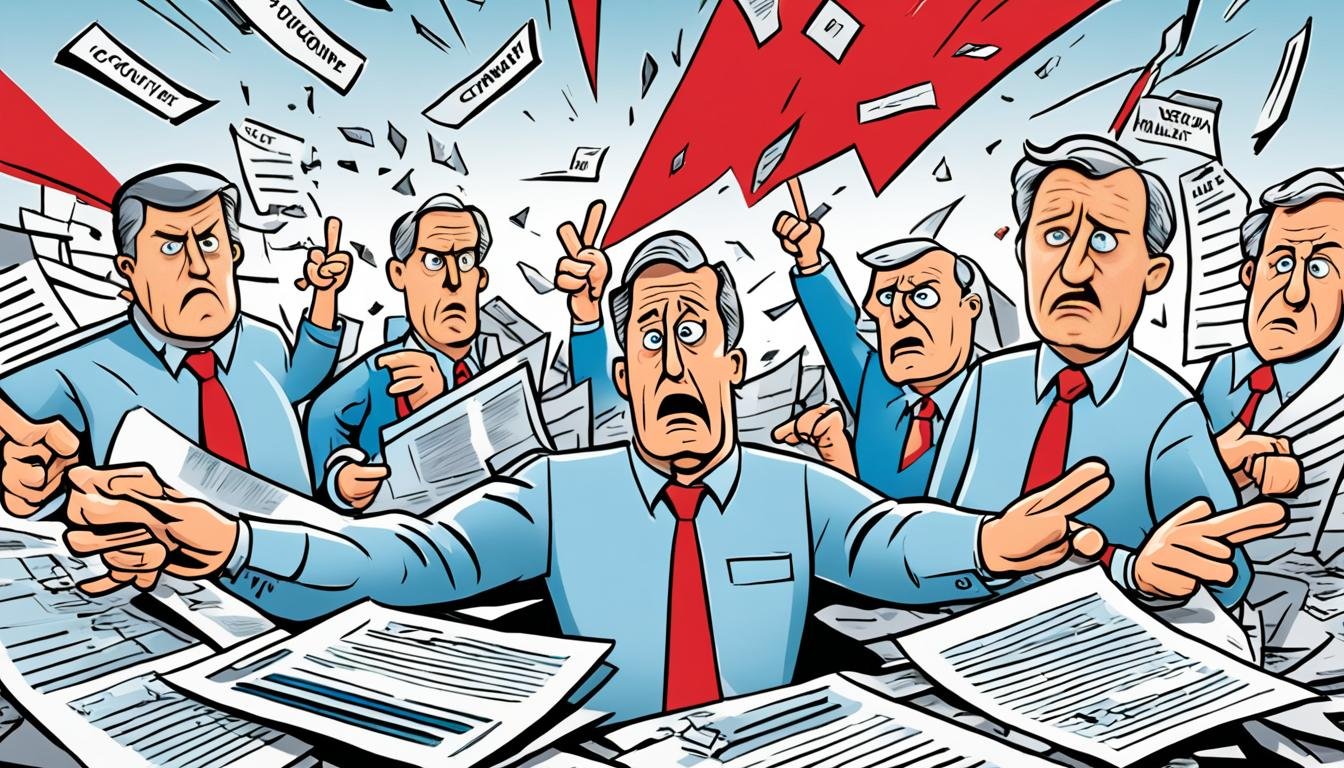The Collapse of Carillion: A Case Study in Corporate Financial Mismanagement
Welcome to our in-depth analysis of the collapse of Carillion, a UK-based construction and services firm that went bankrupt in January 2018. This corporate fraud case study sheds light on the consequences of corporate financial mismanagement and the ripple effects it can have on various stakeholders. Through this examination, we aim to delve into the intricate details of Carillion’s collapse, exploring its causes, implications, and the lessons we can learn from this unfortunate event.
Key Takeaways:
- The collapse of Carillion serves as a shocking example of corporate financial mismanagement.
- Poor strategic management, aggressive accounting practices, and weak corporate governance were central factors contributing to Carillion’s collapse.
- The case study reveals the importance of effective risk management, ethical decision-making, and transparency in corporate operations.
- Carillion’s collapse had far-reaching financial implications for suppliers, subcontractors, and pensioners.
- Regulatory efforts and reforms have since been initiated to prevent similar corporate failures in the future.
Background of Carillion’s Collapse
Carillion’s collapse was a direct result of a long-standing pattern of recklessness, hubris, and greed. The company’s relentless pursuit of cash, fueled by acquisitions, rising debt, and expansion into new markets, ultimately led to its downfall. Despite mounting problems, Carillion presented misleading financial accounts and continued to increase its dividend every year. The board’s failure to adequately fund its pension schemes further exacerbated the crisis, as executive bonuses took precedence over long-term obligations. The collapse of Carillion, therefore, should come as no surprise, given the company’s unsustainable practices.
Carillion’s downfall serves as a compelling case study in financial mismanagement, offering valuable insights into the consequences of reckless business strategies and misleading financial reporting. The scandal surrounding Carillion’s collapse has led to a comprehensive evaluation of corporate governance, risk management, and accounting practices within the construction industry and beyond. The Carillion scandal overview provides a stark reminder of the importance of transparency, accountability, and responsible decision-making in ensuring the stability and success of businesses.
“The pursuit of cash at all costs, combined with the board’s disregard for long-term obligations, laid the foundation for Carillion’s collapse.” – Financial Analyst
Strategic Management Failures
Carillion’s collapse can be attributed to strategic management failures, particularly its growth through acquisitions strategy funded by borrowing. The company’s pursuit of rapid expansion and profitability took precedence over long-term sustainability, leading to high-risk strategies and poor decision-making. Carillion failed to properly assess the risks and costs associated with these acquisitions, resulting in unsustainable debt levels.
The company’s approach of growth through acquisitions may initially seem like a promising strategy, but it proved to be a major contributor to its downfall. By focusing on acquiring other companies to fuel expansion, Carillion took on significant financial risk. This high-risk approach left the company vulnerable to market fluctuations and economic downturns, making it difficult to maintain financial stability.
The Risks of Growth through Acquisitions
Growth through acquisitions involves purchasing other companies as a means of expanding market share, diversifying operations, or gaining access to new technologies or markets. While this strategy can offer certain advantages, such as economies of scale and increased competitive advantage, it also carries significant risks.
“By prioritizing growth through acquisitions without proper assessment of associated risks and costs, Carillion placed itself in a precarious financial position. The company’s failure to exercise strategic foresight and consider the long-term implications of its high-risk strategies ultimately led to its collapse.”
In the case of Carillion, the company’s aggressive pursuit of growth through acquisitions led to the accumulation of unsustainable debt. This debt burden, coupled with low margins on large public sector contracts, created a precarious financial situation that ultimately proved untenable.
A table illustrating the acquisitions made by Carillion and their impact on the company’s financial position would further showcase the strategic management failures and the risks associated with growth through acquisitions.
This table demonstrates the acquisitions made by Carillion, the corresponding cost of each acquisition, and the impact on the company’s debt levels. It provides a visual representation of the high-risk strategies employed by Carillion and the resulting escalation of debt, further highlighting the strategic management failures that contributed to the company’s collapse.
In summary, Carillion’s strategic management failures, particularly its growth through acquisitions strategy funded by borrowing, played a significant role in its ultimate collapse. The company’s failure to properly assess the risks and costs associated with these acquisitions, as well as its prioritization of short-term growth over long-term sustainability, demonstrated a lack of strategic foresight and sound decision-making.
Corporate Governance Failures
The collapse of Carillion can largely be attributed to significant corporate governance failures within the company. The board of directors, responsible for overseeing key decision-making and ensuring the organization operates ethically and effectively, failed to fulfill their obligations and exercise proper accountability.
The Carillion board failed to effectively challenge and scrutinize executives, allowing reckless practices to go unchecked. The pursuit of personal profit and success took precedence over governing the organization in the best interests of stakeholders. This lack of board oversight and accountability created an environment ripe for corporate mismanagement.
The most glaring failure on the part of the board was the neglect of risk management. The board ignored warning signs and failed to establish robust risk management systems, failing in its oversight role to assess and mitigate risk adequately. This lack of risk management oversight directly contributed to the company’s downfall.
“The board’s failure to prioritize risk management and fulfill its oversight responsibilities ultimately led to the collapse of Carillion.”
The absence of strong corporate governance allowed for the persistence of unethical practices within the company. And while Carillion’s collapse stemmed from a multitude of issues, the lack of accountability and professionalism displayed by the board played a significant role.
The board should have acted as a safeguard against corporate mismanagement, according to the principles of good governance. However, the Carillion case serves as a stark reminder of the catastrophic consequences that can arise in the absence of effective corporate governance and a lack of board accountability.
Government Oversight and Reforms
Carillion’s collapse also highlighted the need for regulatory reforms to prevent similar corporate governance failures in the future. The UK Government initiated an inquiry into the collapse and has since implemented measures to strengthen corporate governance requirements and improve board accountability.
- Increased scrutiny of board actions and decisions.
- Mandatory disclosure of directors’ conflicts of interest.
- Tightened regulations and enforcement mechanisms for risk management oversight.
- Enhanced transparency in financial reporting and accountability.
These reforms aim to address the corporate governance failures that contributed to Carillion’s collapse and restore public trust in the system.
The Impact of Corporate Governance Failures on Carillion’s Collapse
| Corporate Governance Failures | Impact on Carillion |
|---|---|
| Lack of board accountability | Allowed reckless practices to continue unchecked |
| Failure to challenge executives | Contributed to a culture of mismanagement |
| Lack of risk management oversight | Failed to appropriately assess and mitigate risks |
| Unethical practices | Permitted the persistence of unethical behavior |
The table above summarizes the impact of corporate governance failures on Carillion’s collapse, highlighting the failures that ultimately led to the company’s downfall.
Financial Mismanagement and Aggressive Accounting
Carillion’s collapse can be attributed to its engagement in aggressive accounting practices, which served to conceal the company’s true financial position. Through the manipulation of financial accounts, Carillion managed to mask its financial instability and portray a false image of profitability.
One of the key aspects of this aggressive accounting was the hiding of liabilities, which further exacerbated the company’s financial crisis. By concealing liabilities, Carillion artificially inflated its financial standing, misleading stakeholders including investors and potential clients.
In addition to hiding liabilities, Carillion also made complacent assumptions about the valuation of goodwill. Goodwill refers to the intangible assets that a company possesses, such as reputation and brand value. However, Carillion overestimated the value of its goodwill, creating an inflated perception of the company’s financial health.
These aggressive accounting practices were missed by auditors, raising questions about their due diligence and the effectiveness of the auditing process. The failure to detect these accounting manipulations contributed to a lack of transparency and accountability within the company.
The focus on short-term financial gain and short-sighted decision-making played a significant role in Carillion’s financial mismanagement. By prioritizing immediate profits over long-term sustainability, the company disregarded the potential consequences of its actions.
“The aggressive accounting practices implemented by Carillion were detrimental to its stakeholders and ultimately contributed to its collapse. The company’s pursuit of short-term financial gain, coupled with hidden liabilities and complacent assumptions, created a false perception of stability.”
The consequences of Carillion’s financial mismanagement and aggressive accounting practices were severe. Suppliers and subcontractors were left in financial distress as the company’s collapse resulted in unpaid invoices and contracts. Additionally, the hidden liabilities and financial instability impacted the pensions of Carillion’s employees, causing further uncertainty and strain.
Financial Mismanagement and Aggressive Accounting Table
| Impact | Description |
|---|---|
| Concealment of liabilities | Carillion intentionally hid liabilities to present a more favorable financial position. |
| Complacent assumptions about goodwill valuation | The company overestimated the value of its goodwill, contributing to an inflated financial image. |
| Auditor oversight | Auditors failed to detect the aggressive accounting practices, raising concerns about due diligence. |
| Short-term focus | Carillion prioritized immediate profits over long-term sustainability, neglecting potential consequences. |
| Supplier and subcontractor distress | The collapse left suppliers and subcontractors with unpaid invoices and contracts. |
| Pension uncertainty | Carillion’s financial instability impacted employee pensions, causing further distress. |
Political Risk and Public Perception
The scandal surrounding Carillion’s collapse shattered the belief that private sector management was inherently superior. The incident triggered a shift in public perception, with growing support for the notion of nationalization as a safeguard against similar corporate failures. It became evident that stronger regulation and oversight of large public sector contracts were necessary to prevent mismanagement and protect public interests.
The Carillion case exposed the risks associated with placing excessive trust in private entities when critical public services and infrastructure are at stake. The public began to question the ability of private companies to prioritize the well-being of society over their own financial gain.
“The Carillion scandal serves as a stark reminder that the pursuit of profit should never come at the expense of public welfare.”
The negative repercussions of Carillion’s collapse extended beyond financial losses. It highlighted the need to reevaluate the allocation of public resources and the potential consequences of relying solely on private sector involvement. As a result, nationalization emerged as a feasible solution to minimize political risk and regain public trust.
Nationalization: A Controversial Proposal
The concept of nationalization, which involves bringing industries and services under government control, gained renewed support following the Carillion collapse. Proponents argued that nationalization could enhance transparency, accountability, and public oversight. By eliminating profit-driven motives, nationalization could prioritize long-term sustainability and social welfare.
However, the idea of nationalization also faced criticism. Opponents expressed concerns over potential inefficiencies, lack of competition, and the burden on taxpayers. Maintaining a delicate balance between effective public management and private sector efficiency is a complex challenge.
The Importance of Political Risk Mitigation
Carillion’s collapse demonstrated the significant political risks inherent in large-scale public-private partnerships. Governments must take proactive measures to mitigate these risks by implementing robust regulatory frameworks and establishing strong oversight mechanisms. Transparency, accountability, and stringent performance monitoring are crucial for ensuring the successful execution of public contracts.
Furthermore, public perception plays a vital role in influencing political decisions. The Carillion scandal heightened public awareness and scrutiny surrounding public sector contracting, creating a demand for increased transparency and accountability from both private companies and public authorities.
The Path Forward: Striking a Balance
Addressing political risk and public perception requires a delicate balance between private sector participation and effective governance. Governments should collaborate with the private sector while prioritizing the interests of citizens and safeguarding public resources. Public-private partnerships must be approached with caution, considering the potential risks and benefits.
By learning from the Carillion scandal, policymakers, regulators, and industry stakeholders can work together to establish stringent standards and procurement practices that mitigate political risks and foster public trust. Collaborative efforts can lead to a more resilient and accountable system that avoids the pitfalls of unchecked private sector involvement.
Lessons Learned and Implications
The collapse of Carillion provides several important lessons for businesses and regulators. It emphasizes the importance of effective corporate governance, risk management, and financial oversight. It also highlights the need for transparency, accountability, and ethical decision-making at all levels of an organization. The implications of Carillion’s collapse extend beyond the construction industry and serve as a cautionary tale for businesses in any sector.
The failure of Carillion underscores the critical role of corporate oversight failures in the downfall of a company. The lack of proper internal controls and board governance allowed unsustainable practices and financial mismanagement to persist, ultimately leading to the company’s collapse.
“The collapse of Carillion should serve as a wake-up call for businesses and regulators alike. It is a stark reminder of the devastating consequences that can result from corporate oversight failures.”
The lessons from Carillion’s collapse apply to businesses of all sizes. They highlight the need for organizations to devote significant attention to their financial stability, risk mitigation strategies, and ethical practices. By implementing effective governance structures, risk management frameworks, and financial oversight mechanisms, companies can avoid the same fate as Carillion.
Implications for Businesses
Carillion’s collapse highlights the following key implications for businesses:
- Priority on sustainable growth rather than short-term gains
- Establishment of robust risk management frameworks
- Regular financial assessments and accounting transparency
- Strengthening of corporate governance practices
- Cultivation of a culture of ethical decision-making
By incorporating these lessons into their operations, businesses can build resilience, enhance stakeholder trust, and ensure their long-term success.
Implications for Regulators
The collapse of Carillion also poses important implications for regulators:
- Enhanced oversight and monitoring of high-risk industries
- Tighter regulations for financial reporting and auditing practices
- Imposing stricter penalties for corporate misconduct
- Encouraging greater transparency and disclosure requirements
Regulators play a crucial role in safeguarding the interests of shareholders, employees, and the wider public. Learning from the Carillion collapse, they must take proactive measures to prevent similar failures and protect the economy from the devastating consequences of corporate mismanagement.
| Lessons Learned | Implications |
|---|---|
| Effective corporate governance | Prioritize sustainable growth |
| Risk management and financial oversight | Establish robust risk management frameworks |
| Transparency and accountability | Regular financial assessments and accounting transparency |
| Ethical decision-making | Strengthen corporate governance practices |
The collapse of Carillion serves as a stark reminder of the far-reaching consequences of corporate oversight failures. It is imperative that businesses and regulators learn from this case study and take proactive steps to prevent similar collapses in the future.
The Role of Internal Audit and Assurance Providers
Carillion’s collapse has brought into question the effectiveness of internal audit and assurance providers in safeguarding organizations from financial risks. One notable example is Deloitte, Carillion’s internal auditor, which failed to fulfill its role in risk management and financial controls.
Deloitte’s recommendations often lacked priority and did not receive the attention they deserved. Their failure to identify and effectively communicate risks contributed to the downfall of Carillion. This highlights the pressing need for stronger risk management oversight within organizations, as well as the importance of reliable and competent assurance providers.
To prevent the repetition of such failures, organizations must establish robust risk management frameworks and ensure that internal auditors have the necessary independence, expertise, and authority to effectively identify, assess, and communicate risks.
Effective risk management oversight entails:
- Clearly defining and communicating risk management responsibilities and expectations
- Regularly monitoring and evaluating the effectiveness of risk management processes
- Providing adequate resources and support to internal audit teams
In the words of Warren Buffett, “Risk comes from not knowing what you are doing.” In the case of Carillion, the failure of internal audit and assurance providers to address risks resulted in catastrophic consequences.
Organizations should also consider external assurance providers who can provide an independent assessment of risk management practices. External auditors, in particular, play a critical role in evaluating the accuracy and reliability of financial information and providing an objective assessment of an organization’s financial health.
The Importance of Reliable Assurance Providers
Reliable assurance providers are essential in ensuring that organizations remain vigilant against potential risks and are equipped with robust risk management processes. They serve as a check-and-balance mechanism, providing an independent evaluation of an organization’s internal controls and risk management systems.
When selecting assurance providers, organizations should prioritize:
- Their reputation and expertise in the industry
- Their track record of successfully identifying and addressing risks
- Their commitment to maintaining professional standards and ethical conduct
By partnering with reliable assurance providers, organizations can enhance their risk management practices, strengthen their internal controls, and safeguard against potential financial disasters. These partnerships foster transparency, credibility, and trust in the eyes of stakeholders, including investors, shareholders, and the public.
| Key Takeaways |
|---|
| 1. Internal audit and assurance providers play a critical role in risk management oversight. |
| 2. The failure of internal auditors to effectively identify and communicate risks can have catastrophic consequences, as demonstrated by the collapse of Carillion. |
| 3. Organizations must prioritize stronger risk management oversight and establish robust frameworks to prevent similar failures. |
| 4. Reliable assurance providers, both internal and external, are vital in evaluating and enhancing risk management processes. |
By taking these steps, organizations can proactively mitigate risks, ensure financial stability, and safeguard the interests of their stakeholders.
Carillion’s Impact on Stakeholders
The collapse of Carillion had a profound impact on various stakeholders, leading to significant financial repercussions for many individuals and organizations involved. Two key groups that were particularly affected by the collapse were suppliers and pensioners.
Financial Implications for Suppliers
Suppliers and subcontractors who were engaged in business with Carillion were severely impacted by the collapse. Many of them were left unpaid for the services and goods they provided, causing immense financial strain and jeopardizing the survival of their own businesses. The sudden loss of income from a major client like Carillion had severe implications, potentially pushing some suppliers to the brink of bankruptcy.
Uncertainty for Pensioners
Another group significantly impacted by the collapse of Carillion were pensioners. The company’s substantial pension deficit meant that there was uncertainty surrounding the future of pension payments for retired employees. Pensioners faced the possibility of reduced retirement benefits, leading to increased financial insecurity after relying on Carillion’s pension scheme to support their post-work life.
Both suppliers and pensioners found themselves grappling with the consequences of Carillion’s failure, highlighting the far-reaching implications of the company’s collapse on individuals and organizations.
Regulatory Efforts and Reforms
The collapse of Carillion had far-reaching implications that prompted a swift response from regulators and policymakers. The severity of the situation necessitated the implementation of robust regulatory measures aimed at preventing similar corporate failures in the future and restoring public trust in the corporate sector. Key areas of focus include:
- Enhancing Corporate Governance: Reforms are being introduced to strengthen corporate governance frameworks, ensuring greater accountability and transparency in decision-making processes. Companies are encouraged to adopt best corporate governance practices and establish effective board oversight mechanisms.
- Improving Risk Management: Regulatory efforts are aimed at fortifying risk management practices within companies. This includes enhancing internal controls, implementing regular risk assessments, and fostering a risk-aware culture at all levels of the organization.
- Strengthening Financial Reporting Standards: Reforms seek to promote more accurate and transparent financial reporting, ensuring that companies disclose essential information to stakeholders. Stricter regulations may require companies to provide comprehensive disclosures regarding their financial health, potential risks, and liabilities.
These regulatory efforts are essential in restoring confidence in the corporate sector and preventing future collapses like Carillion. By bolstering corporate governance, risk management, and financial reporting frameworks, regulators aim to create a more robust business environment that prioritizes responsible practices, stakeholder interests, and long-term sustainability.
Impact on Corporate Practices
“The reforms resulting from the Carillion scandal have the potential to reshape corporate oversight and promote more responsible business practices.”
As a direct result of the Carillion collapse, companies are reevaluating their strategic approaches to growth, risk management, and financial reporting. The case study serves as a stark reminder of the devastating consequences that can arise from unsustainable business practices. Organizations are now more inclined to prioritize transparency, ethical decision-making, and shareholder value over short-term gains.
The regulatory efforts post-Carillion have initiated a paradigm shift in corporate conduct, emphasizing the importance of long-term sustainability and stakeholder trust. Companies are adopting more cautious and responsible strategies, focusing on organic growth, prudent financial management, and the welfare of pension schemes. Through these reforms, businesses are striving to rebuild public confidence and establish a resilient corporate landscape.
Conclusion
The collapse of Carillion stands as a stark illustration of the perils of corporate financial mismanagement. This case study exposes the grave risks associated with unsustainable growth strategies, weak corporate governance, and aggressive accounting practices. It serves as a potent reminder of the critical importance for organizations to prioritize long-term sustainability, ethical decision-making, and effective risk management. The Carillion scandal serves as a powerful call to action, emphasizing the absolute necessity of robust corporate oversight to ensure the stability and success of businesses.
One of the key takeaways from the Carillion case is the need for companies to shift their focus from short-term gains to long-term sustainability. By sacrificing long-term viability for immediate profits, Carillion ultimately sealed its own fate. This highlights the profound significance of strategic management and the importance of careful evaluation of growth plans and acquisitions. Organizations must critically assess the risks and costs associated with their actions to avoid falling into similar traps of excessive debt and unsustainable practices.
The collapse of Carillion also underscores the indispensable role of strong corporate governance in preventing financial catastrophes. With Carillion, the board failed to effectively challenge executives, allowing reckless practices to persist. This lack of accountability and professionalism further contributed to the company’s downfall. The case serves as a vital lesson in the need for boards to prioritize the best interests of stakeholders and to exercise rigorous oversight and risk management.
Source Links
- https://www.imd.org/research-knowledge/finance/case-studies/carillion-high-debt-mismanagement-and-increased-political-risk/
- https://nordopen.nord.no/nord-xmlui/bitstream/handle/11250/2723586/Hajikazemi.pdf?sequence=5&isAllowed=y
- https://www.linkedin.com/pulse/carillion-case-study-corporate-defense-fiasco-sean-lyons








